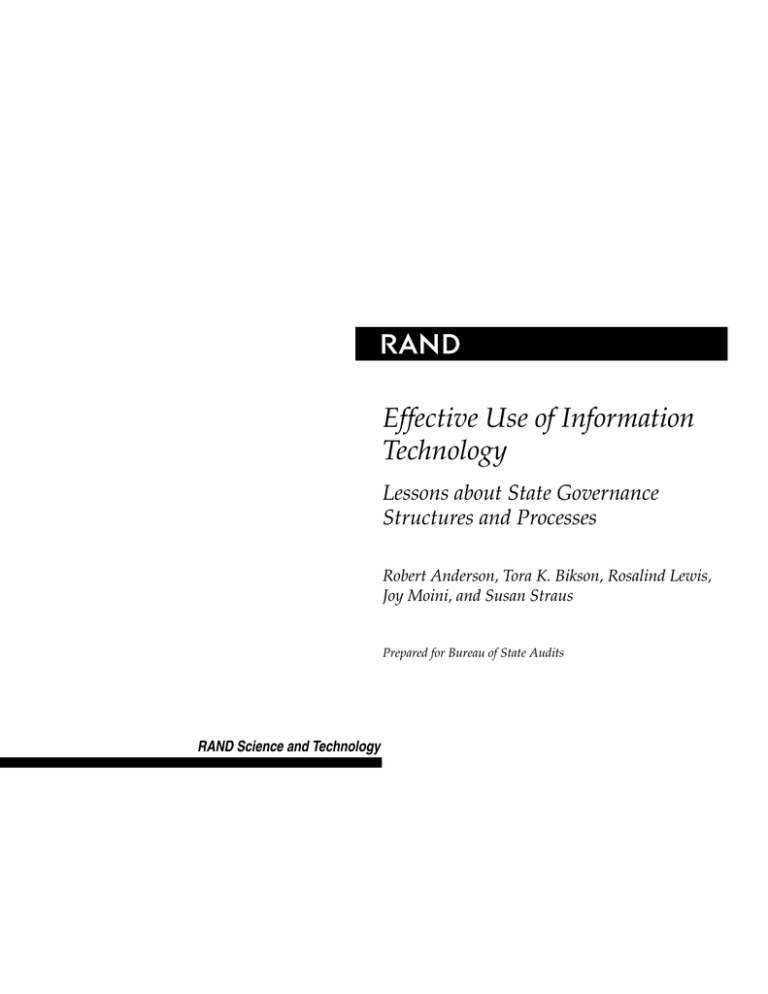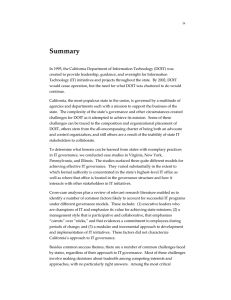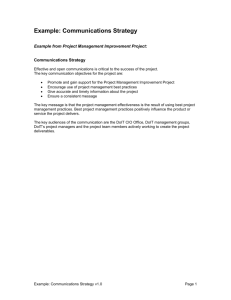
R
Effective Use of Information
Technology
Lessons about State Governance
Structures and Processes
Robert Anderson, Tora K. Bikson, Rosalind Lewis,
Joy Moini, and Susan Straus
Prepared for Bureau of State Audits
RAND Science and Technology
The research described in this report was conducted by RAND
Science and Technology for the Bureau of State Audits.
Library of Congress Cataloging-in-Publication Data
Effective use of information technology : lessons about state governance structures and processes / Robert H. Anderson ... [et al.].
p. cm.
“MR-1704.”
ISBN 0-8330-3426-X
1. Information technology—Government policy—California. 2. Information
technology—Government policy—United States—States. I. Anderson, Robert H.
(Robert Helms), 1939–
JK8749.A8E34 2003
352.3'84'09794—dc21
2003009405
RAND is a nonprofit institution that helps improve policy and
decisionmaking through research and analysis. RAND ® is a
registered trademark. RAND’s publications do not necessarily reflect
the opinions or policies of its research sponsors.
© Copyright 2003 RAND
All rights reserved. No part of this book may be reproduced in any
for m by any electr onic or mechanical means (including
photocopying, recording, or information storage and retrieval)
without permission in writing from RAND.
Published 2003 by RAND
1700 Main Street, P.O. Box 2138, Santa Monica, CA 90407-2138
1200 South Hayes Street, Arlington, VA 22202-5050
201 North Craig Street, Suite 202, Pittsburgh, PA 15213-1516
RAND URL: http://www.rand.org/
To order RAND documents or to obtain additional information,
contact Distribution Services: Telephone: (310) 451-7002;
Fax: (310) 451-6915; Email: order@rand.org
iii
Preface
The study reported here was undertaken because of questions being raised about
the effectiveness of information technology (IT) governance in the State of
California. Created in 1995 by the California legislature, the Department of
Information Technology (DOIT) was to provide leadership, guidance, and
oversight for IT initiatives and projects throughout the state. By the summer of
2002, DOIT would cease to exist, but the need for what DOIT was chartered to do
would continue.
RAND, as an independent nonprofit research organization, responded to a
request for proposals to conduct a study of California’s IT governance structures
and strategies for the Bureau of State Audits. The request for proposals resulted
from legislation aimed at determining whether California’s IT program complied
with best practice and identifying any reforms needed. Between the time of the
original legislative request and the awarding of the study contract to RAND,
DOIT’s sunset clause was allowed to take effect. The orientation of the study
was therefore refined to emphasize how California could best take advantage of
prior experience, both in that state and elsewhere, to shape future directions in IT
governance.
This report is intended to inform and advise policymakers in the state of
California about the next steps toward effective IT governance structures and
processes. However, we believe the findings and recommendations will be of
interest to a broader range of decisionmakers, stakeholders, and researchers
concerned with how best to deploy advancing IT to serve public sector missions.
The project was housed within RAND’s Science and Technology (S&T) research
unit. Its charter is to assist government and corporate decisionmakers in
developing options to address challenges created by scientific innovation, rapid
technological change, and world events. RAND S&T’s research agenda is
diverse. Its main areas of concentration are science and technology aspects of
energy supply and use; environmental studies; transportation planning; space
and aerospace issues; information infrastructure; biotechnology; and the federal
R&D portfolio.
iv
Inquiries regarding RAND Science and Technology may be directed to:
Stephen Rattien, Director
RAND Science and Technology
1200 South Hayes Street
Arlington, VA 22202-5050
Phone: (703) 413-1100 x5219
Email: contact-st@rand.org
Website: www.rand.org/scitech/
v
Contents
Preface ..................................................
iii
Figures ..................................................
vii
Summary.................................................
ix
Acknowledgments .......................................... xiii
Acronyms ................................................
xv
1.
INTRODUCTION TO THE RESEARCH .......................
Purpose ..............................................
Overview ...........................................
Objectives ...........................................
Methods..............................................
IT Governance ........................................
Site Selection .........................................
Procedures ..........................................
Analysis Approach.....................................
Organization of the Report ................................
1
1
1
1
2
2
3
4
4
6
2.
CALIFORNIA’S SEARCH FOR EFFECTIVE IT GOVERNANCE .....
The Present Situation ....................................
The Establishment of DOIT Within State Government .............
DOIT’s Roles in Key IT Deployment Processes ..................
Planning ............................................
Approval ............................................
Procurement .........................................
Implementation and Evaluation ...........................
Other Problem Areas ....................................
Organization and Support ...............................
Roles and Functions ....................................
Still Searching for an Answer...............................
7
7
9
11
11
12
13
14
15
15
16
16
3.
ALTERNATIVE MODELS OF EFFECTIVE IT GOVERNANCE ......
Three Governance Models .................................
Consolidated Control: Consolidating Authority for Many Control
Functions in the Central IT Office ........................
Collaborative Leadership: Institutionalizing Strong Collaborative
Control Relationships Between the Central IT Office and Other
Stakeholder Entities ..................................
Advocacy: Establishing a Strong Advocacy Role for a Central IT
Office That Does Not Have Formal IT Control Functions ........
19
19
4.
SUCCESS THEMES .....................................
1. Governance Structure and Organization of Statewide Functions ...
S1.1. Success for Statewide IT Governance Is Enhanced by a
Direct Reporting Relationship to the Governor’s Office ........
20
23
25
29
30
30
vi
5.
6.
2. Roles and Functions of a Statewide Agency ..................
S2.1. States with Successful Information Technology Initiatives
Demonstrate Commitment to Employees During Major
Changes ..........................................
S2.2. Using a Modular Approach to Enterprise Initiatives Has
Numerous Benefits ..................................
3. Management Style and Context ...........................
S3.1. Executive Leadership Support for and Knowledge of
Information Technology is Essential for Success .............
S3.2. A Collaborative Management Style is a Key Factor in States
with Exemplary IT Governance .........................
31
COMMON CHALLENGES TO STATE IT GOVERNANCE .........
1. Governance Structure and Organization of Statewide Functions ...
C1.1. Weigh the Advantages of Centralization Against Meeting
Unique Agency Needs ................................
C1.2. Find a Balance Between Outsourcing and Developing In-
House Competence ..................................
C1.3. Some Challenges Are Government-Specific ..............
2. Roles and Functions of a Statewide IT Agency ................
C2.1. Determine What Amount of Arduous Procurement
Reporting Requirements Is Needed for Accountability.........
C2.2. Determine Whether The Emphasis Should Be on an IT
Strategy or a Business Strategy ..........................
C2.3. Determine the Proper Metrics for Measuring Progress in a
Complex IT Development or Procurement .................
C2.4. Create a State IT Inventory and Ensure a Regular, Simple
Refresh Cycle for Routine IT Office Equipment ..............
C2.5. Decide on the Most Appropriate Degree of
Standardization .....................................
3. Management Style and Context ...........................
C3.1. Create an Approach for Handling the “Graying” of the
State’s IT Workforce .................................
39
39
CONCLUSIONS AND RECOMMENDATIONS .................
Conclusions ...........................................
1. Governance Structure and Organization of Statewide IT
Functions .........................................
2. Roles and Functions of a Statewide IT Agency ...............
3. Management Style and Context .........................
Recommendations ......................................
1. Governance Structure and Organization of Statewide IT
Functions .........................................
2. Roles and Functions of a Statewide IT Agency ...............
3. Management Style and Context .........................
47
47
31
32
33
33
34
40
41
41
43
43
44
44
45
45
46
46
47
49
50
52
52
54
55
Appendix
A. STATE PROFILES ......................................
B. CALIFORNIA INTERVIEW SUMMARIES .....................
C. A SUMMARY OF THE DEPARTMENT’S PROGRESS ............
D. LITERATURE REVIEW ..................................
59
73
79
83
Bibliography ..............................................
87
vii
Figures
1. California’s Information Technology Development Process ......
11
ix
Summary
In 1995, the California Department of Information Technology (DOIT) was
created to provide leadership, guidance, and oversight for Information
Technology (IT) initiatives and projects throughout the state. By 2002, DOIT
would cease operation, but the need for what DOIT was chartered to do would
continue.
California, the most populous state in the union, is governed by a multitude of
agencies and departments each with a mission to support the business of the
state. The complexity of the state’s governance and other circumstances created
challenges for DOIT as it attempted to achieve its mission. Some of these
challenges can be traced to the composition and organizational placement of
DOIT, others stem from the all-encompassing charter of being both an advocate
and control organization, and still others are a result of the inability of state IT
stakeholders to collaborate.
To determine what lessons can be learned from states with exemplary practices
in IT governance, we conducted case studies in Virginia, New York,
Pennsylvania, and Illinois. The studies surfaced three quite different models for
achieving effective IT governance. They varied substantially in the extent to
which formal authority is concentrated in the state’s highest-level IT office as
well as where that office is located in the governance structure and how it
interacts with other stakeholders in IT initiatives.
Cross-case analyses plus a review of relevant research literature enabled us to
identify a number of common factors likely to account for successful IT programs
under different governance models. These include: (1) executive leaders who
are champions of IT and emphasize its value for achieving state missions; (2) a
management style that is participative and collaborative, that emphasizes
“carrots” over “sticks,” and that evidences a commitment to employees during
periods of change; and (3) a modular and incremental approach to development
and implementation of IT initiatives. These factors did not characterize
California’s approach to IT governance.
Besides common success themes, there are a number of common challenges faced
by states, regardless of their approach to IT governance. Most of these challenges
involve making decisions about tradeoffs among competing interests and
approaches, with no particularly right answers. Among the most critical
x
challenges is the need to determine the appropriate amount of centralization of
state IT functions and the degree of standardization of IT systems. A related
challenge is ensuring public values such as equity through competitive
procurement when deciding on the degree of standardization. The decision
whether to outsource IT operations poses a challenge for state government,
which must weigh the benefits of the flexibility gained from contractor-provided
services against developing overdependence on such services. In deciding on the
appropriate strategic approach, states face a challenge in developing an IT
strategic plan focused on IT, or developing a business strategy in which IT plays
a supporting role. Another issue faced by state governments is the establishment
of an IT inventory and a regular refresh cycle of IT office equipment, lessening
the burden of the approval and procurement process requirements for such
routine purposes.
Moreover, operating in the public sector poses some unique challenges that state
governments must face in carrying out their IT operations. Critical decisions
about the type of oversight for IT budgets and procurements must take into
account the appropriate level of oversight to ensure accountability, while giving
agencies enough flexibility and discretion to meet their IT needs. Another
challenge unique to the public sector is the effect of administration turnover on
the continuity of the statewide IT vision. In addition, the lengthy state
government budget cycle causes major problems for IT development. The
impending baby boom retirement also has major implications for the public
sector because of its limited ability to hire enough personnel with the needed IT
skills. Lastly, the importance of executive leadership for IT and the creation of a
collaborative organizational culture are challenges that must be addressed,
particularly in California.
We conclude that other states are providing visionary management, oversight,
and control of major IT initiatives at the state government level in the face of such
challenges. Those states’ governance structures differ in the amount of authority
given to an IT agency. Other states are consolidating state data centers,
foreseeing a variety of advantages. In each of the states studied, there is direct
support from the governor’s office for critical statewide IT initiatives, which
seems to be a key factor in their success. Themes arising from the operation of
other states’ IT agencies are promotion of a modular approach to IT
developments, and the need to deal with complications arising from a yearly
budget planning and approval cycle. Our California interviews lead to the
conclusions that the former California DOIT was not sufficiently effective, and
that leadership style appears to be a critical success factor. Part of the
management style and context in other states’ effective IT programs is use of IT
xi
oversight and advisory boards, and widespread use of master service agreements
and statewide license agreements. We also conclude that, since IT oversight and
governance in California has now been reconsolidated within the Department of
Finance, moving some of this authority to a new agency will involve significant
power shifts, possibly resulting in compromises of the type that crippled the
previous DOIT.
On the basis of lessons learned in other states, we recommend that a new agency
of information technology be established for California, reporting directly to the
Office of the Governor. Existing statewide IT data centers should report directly
to this new agency, and the existing offices of e-government and IT innovation
should be consolidated within the new IT agency. The technical parts of the
existing Technology Investment and Review Unit (TIRU) and Technology
Oversight Review Unit (TOSU) groups within Finance should also be transferred
to the new IT agency. The key roles for the new IT agency involve advocacy of
statewide IT initiatives, coordination of IT activities, and technical approval of
major IT projects and procurements. The new agency should establish a context
and management style conducive to success, including stress on modular
development and early successes in IT projects and development of regular,
collegial relations with Finance, the Legislature, and agency and department
CIOs. It should be encouraged to establish advisory boards. The agency should
also address change management issues, including specifically the treatment of
state IT employees as new systems and skills are required and older ones become
obsolete, as well as workforce issues related to the potential retirement of large
numbers of the IT workforce within coming years. Developing effective
governance structures and processes for the state’s deployment and use of IT
should be regarded as critical to California’s vitality in the 21st century.
xiii
Acknowledgments
We are indebted to the staff of California’s Bureau of State Audits for their
assistance in developing and carrying out this research. They provided
background reports and documents for state IT-related activities, facilitated
contacts with numerous state agencies, and offered collegial support throughout
the project. We especially want to recognize the efforts of Norm Calloway
(Project Manager) and Doug Cordiner (Audit Principal) who painstakingly
reviewed earlier drafts of this report.
We would also like to acknowledge several RAND colleagues for their
contributions to the project. Special thanks go to Rachel Rue for her invaluable
help with a review of recent journal literature and to Michael Woodward for his
skillful preparation of project reports (many versions) and related
documentation. Additionally, we are grateful to Edward Balkovich and J. D.
Eveland for their insightful and timely reviews of the final manuscript.
Finally, we wish to thank the state agencies in California, Illinois, New York,
Pennsylvania, and Virginia that took part in this study. Their representatives
made time available to cooperate in the research, candidly sharing their
knowledge and experience. We learned a great deal from them.
xv
Acronyms
AIO
Agency Information Officer
BCP
Budget Change Proposal
BOE
Board of Equalization
BSA
Bureau of State Audits
Caltrans
California Department of Transportation
CCS
(Bureau of) Consolidated Computer Services
CIO
Chief Information Officer
CMAS
California Multiple Award Schedule
CMS
Central Management Services
COTS
Council on Technology Services
CTO
Chief Technology Officer
DGS
Department of General Services
DIT
Department of Information Technology
DMV
Department of Motor Vehicles
DOB
Division of the Budget
DOF
Department of Finance
DOIT
Department of Information Technology
DTP
Department of Technology Planning
ECO
Electronic Collections Online
EDD
Employment Development Department
ELA
Enterprise License Agreement
ERI
Early Retirement Initiative
ERIC
Education Resource Information Center
ERP
Enterprise Resource Planning
FSR
Feasibility Study Report
GIS
Geographic Information System
GSP
Gross State Product
HIPAA
Health Information Portability and Accountability Act
IPOC
Independent Project Oversight Consultant
xvi
IRM
Information Resources Management
IT
Information Technology
ITB
Information Technology Bulletin
ITEPS
Illinois Technology Enterprise Planning System
ITP
Intent to Procure
ITQ
Invitation to Qualify
IV&V
Independent Verification and Validation
J-NET
Pennsylvania’s Justice Network
MSA
Master Service Agreement
OA
Office of Administration
OB
Office of Budget
OFT
Office for Technology
OGS
Office of General Services
OIT
Office of Information Technology
PAIS
Public Affairs Information Service
ROI
Return on Investment
SOIT
State Office of Information Technology
SPR
Special Project Report
TIP
Technology Investment Program
TIRU
Technology Investment and Review Unit
TOSU
Technology Oversight Review Unit
VIPnet
Virginia Information Providers Network Authority





